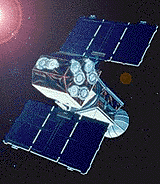EUVE
Extreme Ultraviolet Explorer
 The objectives of the EUVE mission are to: (1) produce a high-sensitivity "all-sky" survey in the 70- to 760-angstrom portion of the spectrum; (2) perform a "deep survey" of a strip of the sky along the ecliptic with extremely high sensitivity; (3) perform follow-up spectroscopic observations on bright extreme ultraviolet point sources; (4) study stellar evolution and the local stellar population; (5) investigate energy transport in stellar atmospheres; and (6) study ionization and opacity of the interstellar medium. The initial "all-sky" survey was completed in January 1993, and a Guest Observer program was initiated in February, 1993. EUVE is controlled from the Center for EUV Astrophysics at the University of California, Berkeley.
The objectives of the EUVE mission are to: (1) produce a high-sensitivity "all-sky" survey in the 70- to 760-angstrom portion of the spectrum; (2) perform a "deep survey" of a strip of the sky along the ecliptic with extremely high sensitivity; (3) perform follow-up spectroscopic observations on bright extreme ultraviolet point sources; (4) study stellar evolution and the local stellar population; (5) investigate energy transport in stellar atmospheres; and (6) study ionization and opacity of the interstellar medium. The initial "all-sky" survey was completed in January 1993, and a Guest Observer program was initiated in February, 1993. EUVE is controlled from the Center for EUV Astrophysics at the University of California, Berkeley.
Spacecraft
Based on the NASA/Fairchild Multi-Mission Spacecraft (MMS) bus. 3-axis stabilized. Downlink through TDRSS at 512 kbit/sec. Designed for on-orbit servicing by the Shuttle.
Payload
Three grazing incidence UV telescopes covering 80-900 angstroms (188 kg each). One EUV spectrometer (323 kg). The scanning telescopes will compile all-sky maps over 80-900 angstroms with positional accuracy of 0.1 deg. The spectrometer will observe in the anti-Sun direction along
the ecliptic, to complete a survey in two bands between 80-500 angstroms.
| Country of Origin | United States |
| Customer/User | GSFC, University of California Space Sciences Lab |
| Manufacturer(s) | NASA Goddard Space Flight Center, Fairchild |
| Size | 4.5 x 3 meters |
| Orbit | 528 km, incl. = 28.5 deg |
| Design Life | 19 months |
| Related Sites | Center for EUV Astrophysics |
Launch Facts
| Name | Int'l Desig. | Date | Site | Vehicle | Orbit | Mass(kg) |
| Notes | ||||||
| EUVE | 1992-031A | 6/7/92 | ESMC | Delta 6920-10 | LEO | 3275 |
| Extreme Ultra-Violet Explorer; mapped galactic EUV sources | ||||||
Information in The Mission and Spacecraft Library is provided without warranty or guarantee. USE AT YOUR OWN RISK.